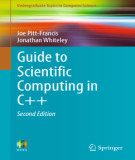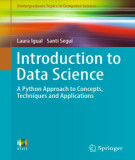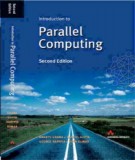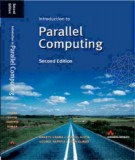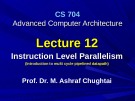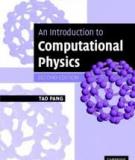
Introduction to Parallel Computing
-
Continued part 1, part 2 of ebook "Guide to scientific computing in C++ (Second edition)" has presents the following content: templates; errors, exceptions and testing; developing classes for linear algebra calculations; an introduction to parallel programming using MPI; designing object-oriented numerical libraries; linear algebra; other programming constructs you might meet; solutions to exercises;....
 139p
139p  dieptieuung
dieptieuung
 20-07-2023
20-07-2023
 7
7
 4
4
 Download
Download
-
Continued part 1, part 2 of ebook "Introduction to data science: A python approach to concepts, techniques and applications" has presents the following content: unsupervised learning; network analysis; recommender systems; statistical natural language processing for sentiment analysis; parallel computing;...
 100p
100p  dieptieuung
dieptieuung
 20-07-2023
20-07-2023
 9
9
 5
5
 Download
Download
-
Ebook Computer Organization and Architecture/Introduction to Computer Organization and Architecture: Part 2 presents the following content: Computer Arithmetic I; Computer Arithmetic II; Input/Output Organization; Memory Organization Concepts; Introduction to Parallel Processing;... Please refer to the documentation for more details.
 125p
125p  chankora
chankora
 16-06-2023
16-06-2023
 4
4
 3
3
 Download
Download
-
Part 1 of book "Introduction to Parallel Computing (Second edition)" provide with knowledge about: introduction to parallel computing; parallel programming platforms; principles of parallel algorithm design; basic communication operations; analytical modeling of parallel programs; programming using the message-passing paradigm;...
 291p
291p  britaikridanik
britaikridanik
 05-07-2022
05-07-2022
 6
6
 3
3
 Download
Download
-
Continued part 1, part 2 of book "Introduction to Parallel Computing (Second edition)" provide with knowledge about: programming shared address space platforms; dense matrix algorithms; sorting and bibliographic remarks; graph algorithms; search algorithms for discrete optimization problems; dynamic programming; fast fourier transform;...
 321p
321p  britaikridanik
britaikridanik
 05-07-2022
05-07-2022
 15
15
 2
2
 Download
Download
-
Advanced Computer Architecture - Lecture 12: Instruction level parallelism. This lecture will cover the following: introduction to multi cycle pipelined datapath; longer pipelines – FP instructions; loop level parallelism; FP loop hazards; typical MIPS FP pipeline; hazards in longer latency pipeline;...
 38p
38p  haoasakura
haoasakura
 30-05-2022
30-05-2022
 12
12
 3
3
 Download
Download
-
We prove that Cayley graphs of SL2 (Fp ) are expanders with respect to the projection of any fixed elements in SL(2, Z) generating a non-elementary subgroup, and with respect to generators chosen at random in SL2 (Fp ). 1. Introduction Expanders are highly-connected sparse graphs widely used in computer science, in areas ranging from parallel computation to complexity theory and cryptography; recently they also have found some remarkable applications in pure mathematics; see [5],[10], [15], [20], [21] and references therein. ...
 19p
19p  dontetvui
dontetvui
 17-01-2013
17-01-2013
 47
47
 6
6
 Download
Download
-
text is designed for an introductory probability course at the university level for sophomores, juniors, and seniors in mathematics, physical and social sciences, engineering, and computer science. It presents a thorough treatment of ideas and techniques necessary for a firm understanding of the subject. The text is also recommended for use in discrete probability courses. The material is organized so that the discrete and continuous probability discussions are presented in a separate, but parallel, manner.
 518p
518p  paradise_12
paradise_12
 03-01-2013
03-01-2013
 91
91
 13
13
 Download
Download
-
Computing has become a necessary means of scientific study. Even in ancient times, the quantification of gained knowledge played an essential role in the further development of mankind. In this chapter, we will discuss the role of computation in advancing scientific knowledge and outline the current status of computational science. We will only provide a quick tour of the subject here. A more detailed discussion on the development of computational science and computers can be found in Moreau (1984) and Nash (1990).
 402p
402p  tiramisu0908
tiramisu0908
 17-10-2012
17-10-2012
 57
57
 6
6
 Download
Download
-
Face recognition is still a vividly researched area in computer science. First attempts were made in early 1970-ies, but a real boom happened around 1988, parallel with a large increase in computational power. The first widely accepted algorithm of that time was the PCA or eigenfaces method, which even today is used not only as a benchmark method to compare new methods to, but as a base for many methods derived from the original idea.
 246p
246p  bi_bi1
bi_bi1
 11-07-2012
11-07-2012
 66
66
 7
7
 Download
Download
-
Parallel and distributed computing has offered the opportunity of solving a wide range of computationally intensive problems by increasing the computing power of sequential computers. Although important improvements have been achieved in this field in the last 30 years, there are still many unresolved issues. These issues arise from several broad areas, such as the design of parallel systems and scalable interconnects, the efficient distribution of processing tasks, or the development of parallel algorithms....
 298p
298p  bi_bi1
bi_bi1
 11-07-2012
11-07-2012
 79
79
 7
7
 Download
Download
-
Computer simulation has become an essential par t of science and engineering. Digital analysis of components, in particular, is important when developing new products or optimizing designs. Today a broad spectrum of options for simulation is available; researchers use everything from basic programming languages to various high-level packages implementing advanced methods. Though each of these techniques has its own unique attributes, they all share a common concern: Can you rely on the results?...
 101p
101p  ruanyuwei1205
ruanyuwei1205
 01-12-2011
01-12-2011
 131
131
 28
28
 Download
Download
-
CHAPTER 13 COMPUTER-AIDED DESIGN Dr. Emory W. Zimmers, Jr., & Technical Staff Enterprise Systems Center Lehigh University Bethlehem, PA 13.1 INTRODUCTION TO COMPUTER-AIDED DESIGN (CAD) 13.1.1 A Historical Perspective of CAD 13.1.2 The Design Process 13.1.3 Applying Computers to Design HARDWARE 13.2.1 Input/Output and Central Processing Unit (CPU) THE COMPUTER 13.3.1 Computer Evolution 13.3.2 Categories of Computers 13.3.3 Central Processing Unit (CPU) 13.3.4 RISC and CISC Computers 13.3.5 Parallel Processing MEMORYSYSTEMS 13.4.1 Organizational Methods 13.4.
 22p
22p  hadalabo
hadalabo
 29-09-2010
29-09-2010
 207
207
 4
4
 Download
Download
CHỦ ĐỀ BẠN MUỐN TÌM








